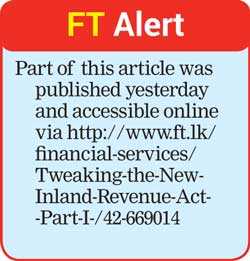Thursday Dec 18, 2025
Thursday Dec 18, 2025
Tuesday, 18 December 2018 00:17 - - {{hitsCtrl.values.hits}}
In the backdrop where the recent amendment to the country’s supreme law is called in question, it may be appropriate to recall that the passage of the new Inland Revenue (IR) Act through Parliament was far more controversial. Nevertheless, the new Act has been in effect since 1 April 2018, and a majority are still scampering to comply with the Act.
Part I of this article highlighted the pros and cons of the general provisions in the Act. In this Part, the focus is onsome of the special provisions in the Act and how these could be tweaked for the better.
Partnerships
The approach to taxation of partnerships has been changed under the new Act. In the old Act, the partnership was liable to pay tax and the partners received a tax credit for the tax paid by the partnership. However, in the new Act, except in the case of a gain from the realisation of an investment asset, the partnership is not liable to pay tax. Instead, it is the partners who are liable to pay tax. The partnership is required to withhold tax at the rate of 8% from each partner’s share of the partnership income. The share of partnership income is treated as business income of the partner and liable for tax at the individual tax rate. The partner receives a tax credit for the withholding tax.
However, there is a lack of clarity in the new Act regarding how the partnership income and/or each partner’s share of the partnership income should be calculated. In the old Act, it was clearly specified that the partnership income should be calculated according to the Act (i.e. taxable income).
Concessionary corporate tax rates
The new Act provides a concessionary tax rate of 14% for small and medium enterprises (SMEs) and defines a SME as having an annual gross revenue of less than Rs. 500 million.
The same concessionary rate is afforded to companies engaged in specific industries with the objective of promoting those industries, which include the agri-business, export and tourism industries. These industries enjoyed similar concessionary rates under the old Act and it is disheartening to see some of the highest earning corporates in the country consistently pay tax at concessionary rates. Not only is the Government losing substantial tax revenue, but it also stifles the growth of SMEs in these industries.
Therefore, the authorities should reconsider the blanket concessionary rate and apply the same qualification criteria as for SMEs or something similar. It should also be noted that the export definition includes ‘specified undertaking’ and the scope of specified undertaking has been widened to include several new lines of business relating export and import, where some of the highest earning corporates operate.
Life insurance business
Tax reform relating to the life insurance business has been a long time coming. More for the powerful lobbyists than the objective to develop the life insurance industry, one of the most profitable businesses has paid little or no tax in the past. Under the old Act, it was only the investment income of the life insurance fund that was treated as business income and all expenses relating the life insurance business were set off against such income, resulting in a taxable loss more often than not.
The new Act makes amends for this by treating as the income of the life insurance business the aggregate of; the surplus distributed to the shareholders from the life insurance fund, and the investment income of the shareholders fund less expenses. However, authorities may have gone slightly overboard by treating the surplus distributed to the participating policyholders (bonus) also as a part of the income of the life insurance business.This portion of the surplus of the life insurance fund is initially liable for tax at a concessionary rate of 14%.
Since this could have a detrimental effect on the industry and policyholders as well, the authorities could consider an alternative where the tax paid on the surplus distributed to policyholders is treated as a tax paid by the policyholder and granted a tax credit in respect thereof. Such an alternative will help to promote the life insurance business given that the new Act does not afford any concessions to the life insurance business.
However, what is of more concern to the authorities is the deferred tax asset conundrum. The Act allows for the deduction of unrelieved losses in the previous six years without any restrictions and this has resulted in some insurers recognising massive deferred tax assets. This virtually ensures that such insurers will not be liable to pay tax for at least another six years. It is hard to believe that this outcome was intended given the long overdue objective to tax the life insurance business.
Petroleum operations and renewable energy/recycling and waste management
Petroleum operations are afforded a special status in the new Act as in the old one. These provisions are likely to have found their way in due to the Anglo-Saxon/Western influence in drafting of the law.
The authorities should consider elevating to a similar status any investments made in renewable energy projects, and recycling and waste management projects given the wind of change in favour of renewable energy over fossil fuels and the national priorities. The Act only provides a temporary concession to institutions that supply electricity using renewable resources by taxing them at the rate of 14% for the next three years.
Housing concessions
Under the old Act the capital repayment on a loan obtained for the construction or purchase of a house was designated as a qualifying payment. However, the new Act does not afford any concessions of the sort to prospective homeowners. Considering that even developed countries provide tax concessions to encourage home ownership, authorities may want to restore similar concessions as a matter of policy.
Temporary concessions
The new Act provides a temporary concession for headquarters relocating to Sri Lanka, by taxing such institutions at zero percent for the next three years. The relocation of head offices to Sri Lanka accords with the objective to make the country a regional trade/financial hub. Therefore, the authorities may want to consider an extension of this concession into the medium term. However, threshold requirements should be specified as in the case for enhanced capital allowances (investment incentives).
As a temporary concession, an additional deduction of 100% of the research and development expenses is allowed for the next three years. Again, this concession is something that could be extended beyond a temporary concession to promote research and development in the country. Alternatively, authorities could allow for any losses resulting from the deduction of R&D expenses to be carried forward beyond the normal period of six years.
The information technology industry is granted a temporary concession of an additional deduction of 35% of the total amounts paid to employees, provided certain conditions are met by such companies. However, more constructive concessions could be afforded to the IT industry to last well into the medium term given the objective to make Sri Lanka an ICT hub. For instance, enhanced capital allowances could be provided for the hardware, software programs and licenses used by companies that provide offshore services.
Final remarks
As highlighted in Part I and II of this article, irrespective of the controversies surrounding the enactment of the law, this is a vast improvement on its predecessor, and it is reasonable to assume that despite the political rhetoric, the framework/systems introduced by the Act would not be changed at least in the short to medium term. However, as discussed in this two Part article, there are several points in the Act that deserve the attention of the authorities and if these could be addressed, the Act would sit wellwith all the stakeholders.
(The writer is Chief Consultant at SG Business Management Consultancy; [email protected], www.sgbmc.com.lk.)